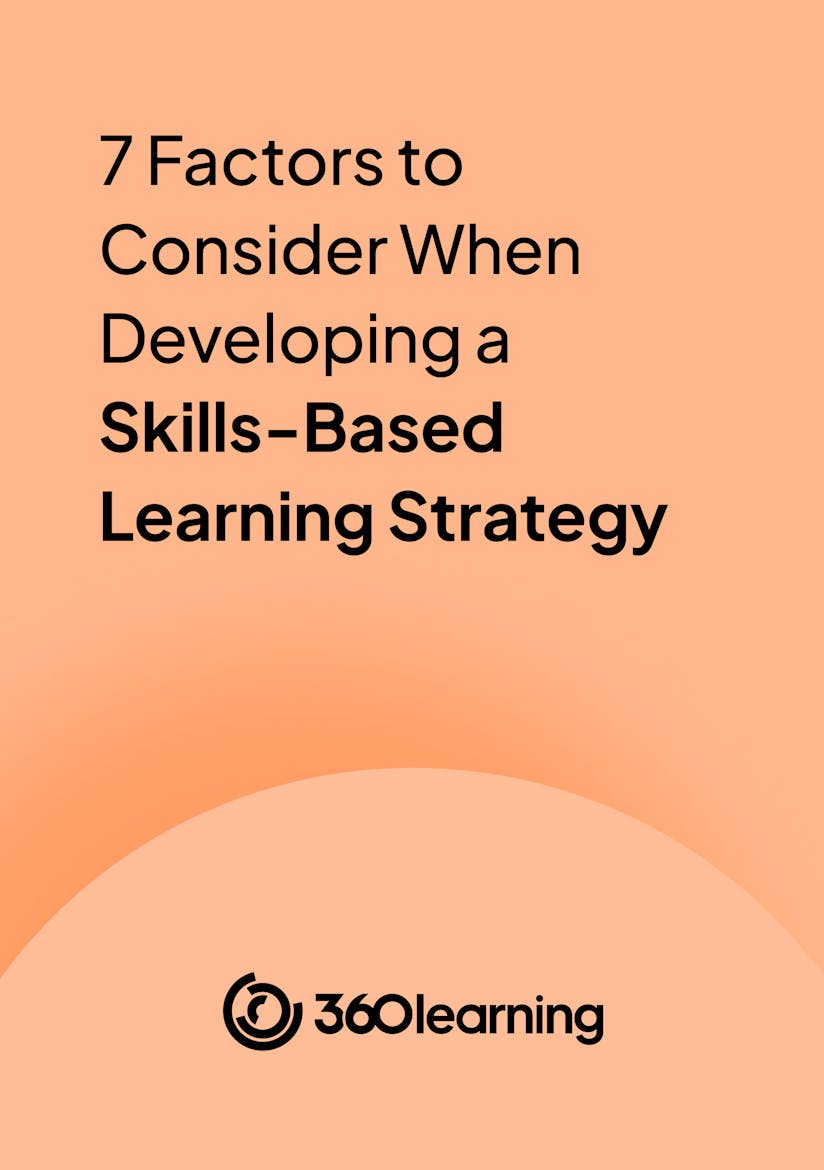
Identifying the most valuable skills for the working world is always a rich debate. Companies hire first and foremost to fill skills gaps — you need talent you don’t currently have.
But should companies hire predominantly for technical skills that solve a relatively narrow issue, or prioritize broader competencies that can adapt to different circumstances?
In this article, we make the case that transferable skills should be given more attention. Not only are these more available in the job market than proprietary skills (by definition), but they equip your company with polyvalent, multi-talented people who can help across the board.
You need those hard skills too, but not at the expense of the fundamental abilities to communicate, take initiative, or lead others.
Let’s explore what this family of skills looks like, and how to make them a core focus of your L&D approach.
What are transferable skills?
A transferable skill is knowledge, know-how or interpersonal skills that are useful (and even essential) to succeed in different job roles, professions, and companies. This type of professional skill is typically contrasted against technical skills — the capabilities needed to perform in a specific role. It’s also different from proprietary skills, which we’ll explain shortly.
Transferable skills can be soft or hard skills and include behavioral aptitude, interpersonal tact, and expertise in the use of business tools or concepts.
We’ll see more examples shortly, but here are a few classics:
- Goal-setting methodology
- Autonomy and/or team work
- Benchmarking and analysis
- Leadership
- Budgeting
- Project management skills
- Coaching, mentoring, and managing others
- Conflict resolution
- Time management
Some specific skills are more in-demand as the nature of work evolves. For remote teams, the ability to work autonomously and meet deadlines may be more valuable than in-person listening skills. Some will also be more emphasized in different industries.
Transferable vs proprietary skills
Transferable skills are applicable generally, and can be advantageous in any company or organization. They can also be learned in any organization, in school, or other training environments.
Proprietary skills belong to a specific organization, and even to specific departments within that organization. They are usually learned and developed in-house, to build towards the specific aims of that company.
While incredibly valuable to an organization, proprietary skills are not designed to be transferable.

Guarantee a successful move to skills-based L&D
By providing your contact info, you agree to receive communications from 360Learning. You can opt-out at any time. For details, refer to our Privacy Policy.
Why factor transferable skills into your L&D strategy?
The ever-evolving job market creates constant tension between the need for versatility and the need for specialization. While technical and proprietary skills will always play a key role in hiring and retention, a clear strategy for developing transferable skills has several distinct advantages.
Create a clearer hiring strategy
Transferable skills belong on job descriptions, just like any other aptitude or capability. So the immediate benefit of defining these internally is you can communicate them externally in the hiring process.
It also sets company-wide expectations for hiring managers about what the ideal profile looks like.
Encourage internal mobility
It’s a shame to see smart, committed workers leave because they’ve either outstayed an existing role or that role is no longer needed. By identifying (and measuring) the most important transferable skills in your organization, you can help talented team members find a new home and keep reinforcing your strong company culture.
Companies can easily spend $10,000 per new hire, and choosing the wrong new employee reportedly costs $17,000 on average. If you can hire from within instead, you lower the risk of hiring people who don’t fit your company culture or clash with their new team mates.
Improve employee retention
The other obvious advantage to internal mobility is that people stay in the business for longer. But even those who don’t move roles are also more likely to stay as they grow in their careers.
Learning and development programs are an underrated (and essential) tool to keep teams engaged and intact for longer. Nearly 50% of employees say they’ll leave their current role for better chances to upskill. So good in-house training is a competitive advantage, and keeps your best people around.
Transferable skills are particularly important here, because they’re the most directly relevant to an employee’s long-term career prospects. They want to build these for the future, so make sure they build them with you.
Boost employee performance
Finally, if you’ve identified specific transferable skills as being important to job performance, then developing these leads to better production. Whether it’s enhanced communication skills, stronger leadership, or precise goal setting, it all helps to make your team members as effective as they can be.
And while not every transferable skill is required for every job role, these are the most likely to be universal. So you may get the best bang for buck company-wide by building these proficiencies over more precise hard skills.
Common examples of transferable skills
If your objective as a training manager is to retain as much of your in-house talent as possible, it's worth finding out which key transferable skills are of interest to today's recruiters.
Indeed, when you set out to develop your employees' transferable skills, you are de facto working on their employability on the job market. And this attention to professional development is a key factor in retaining them. The more you take an interest in developing their knowledge and skills to help them on their career path, the more likely they are to stay with the company that helps them develop.
Here is a list of transferable skills most valued by recruiters today:
- Foreign languages
- Corporate digital tools (word processors, Excel spreadsheets, databases, email, and more)
- Written and verbal communication (internal, customer-facing, tone of voice, public speaking)
- Team building and collaboration
- Autonomy, initiative, and independent thought
- Adaptability
- Methodological skills
- Organization, prioritization, and time management
- Negotiation and persuasion
- Critical thinking, analytical skills and problem solving skills
- Data analysis
- Creative thinking
- Self-evaluation and self-reflection
- Project management; people management
There are, of course, plenty more to add to this list. The key is finding those that are most important to your organization, and then concretely measuring and developing these skills among your teams.
The great benefit to individuals: not only can they list them on their resumes — they could always do that — but they’ll have clear examples of training plans and results to carry throughout their careers.
How transferable skills create career development opportunities
Transferable skills are key to broadening your talent profiles and meeting internal demand. By helping your employees to make use of these skill sets, you can reduce your recruitment needs, facilitate internal mobility between departments, and spot future leaders and managers.
Measuring and training transferable skills also lets managers give more precise career advice, and helps employees develop the specific work experience they need. Place an explicit emphasis on them, so all parties are on the same page and can work towards shared goals.
Career development possibilities
- A product marketing manager with in-depth knowledge of your offering (proprietary), and strong negotiating skills (transferable), could make an excellent sales representative. And they’ll be up to speed in record time.
- An IT engineer, whose job is very operational but who has a strong ability to prioritize tasks (transferable), strong leadership skills (transferable) and fluid communication with others (transferable), who could step up to be IT manager. To be sure, you could look closely at their decision-making, relationship building and the level of emotional intelligence they display.
- A graphic designer with strong adaptability (transferable), autonomy (transferable) and writing skills (transferable), could become a social media manager with some technical training on the platforms and marketing strategy.
How to identify transferable skills
Similar to soft skills, transferable skills can sometimes seem vague. But that’s not inherent in their nature, it just means there’s work to do.
You need to characterize and identify skills gaps to offer the right kinds of training, and to make internal mobility fair for everyone.
To do this, you can draw on a number of sources:
- Job descriptions. The obvious starting point, these list all the skills required for day-to-day work. Simply compare roles to easily identify the skills that cut across the different professions.
And when hiring, ensure you assess these during job interviews and in cover letters, just as you look for technical skills. - A skills map for your departments, or for the company as a whole. This is a document that brings together all the technical, human and interpersonal skills available in a division or group of divisions. It’s ideal to identify skills that cut across several business lines.
- Performance review interviews. During these interviews, HR, the manager and the employee themselves have the opportunity to identify all of that employee’s skills.
- Training courses. Whether this assessment is carried out by a face-to-face trainer, or in a learning management system (LMS), the results can be used to identify the key transferable skills you are looking for.
How to develop transferable skills
Transferable skills are shared by several employees, regardless of the positions or divisions in which they work. As a L&D leader, this is a real opportunity to set up training programs based on peer learning!
Develop these transferable skills by upskilling from within. You can capitalize on the internal skills of all employees, to help everyone develop internally by training each other.
So how do you activate this notion of peer learning in your skills development plan?
Set up a collaborative learning platform
A good learning management platform is vital for effective L&D. A collaborative LMS lets each employee design, create, and edit training content based on their own expertise.
Each team member can build their path forward (within guidelines), and share their own knowledge and experience with others. In doing so, they contribute their transferable skills in modules designed to help their peers develop alongside them.
See our list of the 16 best learning management systems.
Incorporate skills into performance reviews
A well-built LMS also lets you accurately track employee skills on an individual level, at scale. Skill development can then form the core of performance reviews, as managers can instantly see where team members have weaknesses and how they’ve progressed.
The more wide-spread, universal, and equal this system is across the organization, the less you have to worry about people finding it unfair or targeted. The result is objective and productive performance reviews, with clear next steps for career progression.
Implement a mentoring or coaching program for employees
As many transferable skills are soft skills, they need to be applied in a real work context in order to be properly acquired. This is why it is particularly useful to create a link between employees who already have these skills and those who need to learn them, so that the former can give concrete advice to the latter.
Make transferable skills a focus today
L&D professionals have a key role to play in developing and retaining talent in an evolving job market. Implement training programs that develop employees’ transferable skills to both keep them around for longer, and better prepare them for a future career change.
Your next step is simple: dive into skills-based learning and start building your strategy.

Guarantee a successful move to skills-based L&D
By providing your contact info, you agree to receive communications from 360Learning. You can opt-out at any time. For details, refer to our Privacy Policy.




